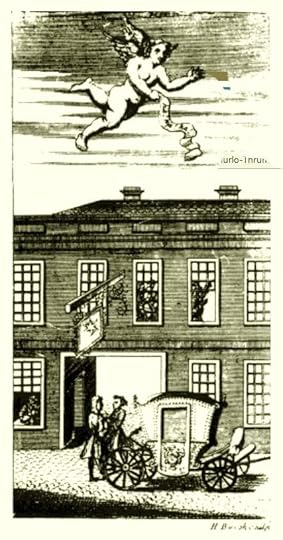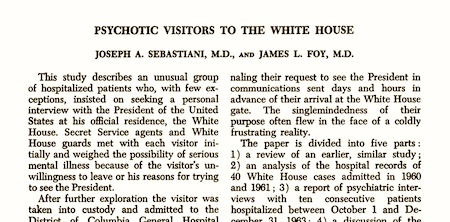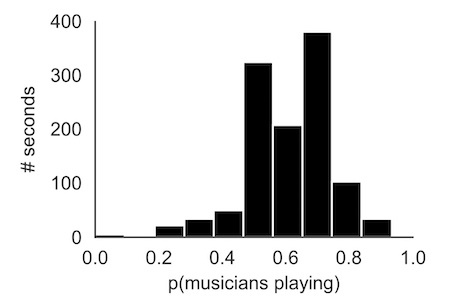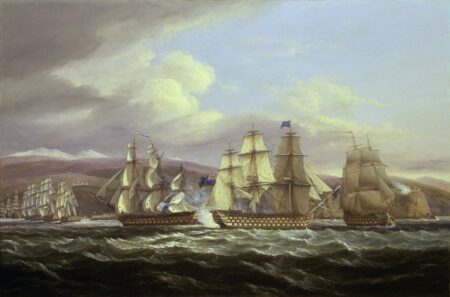Marc Abrahams's Blog, page 90
January 18, 2021
Coffee shop restroom graffiti and their implications for management inquiries [study]
“My intention is to explore what happens when an organization’s bathroom becomes the locus of heated debate and cynical resignation. In contrast to viewing this rarely studied space as irrelevant to culture and identity, I argue that addressing such a space as culturally important has strong implications for understanding how authorship is constituted in organizations.“
So explains Professor Gazi Islam (now at the Grenoble Ecole de Management, France) in an article entitled : Backstage Discourse and the Emergence of Organizational Voices: Exploring Graffiti and Organization. (Journal of Management Inquiry, Volume: 19 issue: 3, page(s): 246-260)
The professor examined the dense and polyphonic communicative acts – in the form of graffiti – that had been found in the bathroom (restroom) of a locally-owned coffee shop in a medium-sized US city.
Graffiti were recorded approximately bi-weekly over 3 years, resulting in 338 separate entries of graffiti texts. Which were subsequently incorporated into a working categorization scheme based on their discursive functions.
“The phenomena I attempt to examine exist in dark corners of the organization but contain novel and interesting information, novel because seldom studied, and interesting, because they have managed to flourish, even in secrecy. These phenomena are organizational in the sense that civil society is political, that is, as spaces where meanings are established that do not enter the formal organizational registers. It is my hope that such a choice of research site, with its unique attributes, will open a door for future research into the more private spheres of organizations.”
Research research by Martin Gardiner

January 17, 2021
Podcast Episode #1051: “Did His Orgasm Lead to Blindness”
In Podcast Episode #1051, Marc Abrahams shows an unfamiliar research study to biomedical researcher Chris Cotsapas. Dramatic readings and reactions ensue.
Remember, our Patreon donors, on most levels, get access to each podcast episode before it is made public.
Chris Cotsapas encounters:
“Postcoital Visual Loss Due to Valsalva Retinopathy,” Michaels, Luke, Naing Latt Tint, and Philip Alexander, BMJ Case Reports, epub October 23, 2014.
Seth Gliksman, Production Assistant
Available on Spotify, Apple Podcasts, Overcast, Google Podcasts, AntennaPod, BeyondPod and elsewhere!

January 16, 2021
Psychotic Visitors to the White House [research study]
The final performance in tonight’s Improbable Dramatic Readings session, at Arisia, was a two-minute-long reading from this research paper:
“Psychotic Visitors to the White House,” Joseph A. Sebastiani and James L. Foy, American Journal of Psychiatry, vol. 122, no. 6, December 1965, pp. 679-86.
The study authors, at the University of Cincinnati and Georgetown University, report: “This study describes an unusual group of hospitalized patients who, with few exceptions, insisted on seeking a personal interview with the President of the United States at his official residence, the White House. Secret Service agents and White House guards met with each visitor initially and weighed the possibility of serious mental illness because of the visitor’s unwillingness to leave or his reasons for trying to see the President.”

TONIGHT: Dramatic Improbable Readings Teledistantly
Tonight we’ll do our first-ever-teledistant Improbable Dramatic Readings event, at Arisia, 6 pm US eastern time.
The dramatic readers —Sonya Taafe, Mason Porter, Robin Abrahams, Dean Grodzins, David Kessler— all are always-boffo performers, and the material is of course ace.
We (Improbable Research) plan to do lots more online Dramatic Readings events elsewhere, in adapting to the pandemic era.
The lotsa-people-gathered-in-a-performance-space Dramatic Readings events always worked well. This first re-engineered, teledistant event is, for me, especially fun and exciting, full of little how-will-we-manage-to-do-THAT-particular-aspect mysteries.

Monkeys Prefer Reality Television [research study]
Some humans might prefer to read the entirety of this study, rather than see any summary that we or anyone else would provide:
“Monkeys Prefer Reality Television,” Eliza Bliss-Moreau [pictured below], Anthony C. Santistevan, and Christopher J. Machad, PsyAxXiv, DOI 10.31234/osf.io/7drpt, 2021. The authors are at the University of California Davis; Flatiron Health, Inc., New York; and Cuesta College, San Luis Obispo, California.

January 15, 2021
Musical Coordination in a Large Group Without Plans or Leaders
An experiment looked at whether harmony, in its many meanings, might emerge from a tossing together of musicians. This study tells what happened:
“Musical Coordination in a Large Group Without Plans Nor Leaders,” Louise Goupil, Pierre Saint-Germier, Gaëlle Rouvier, Diemo Schwarz, and Clément Canonne, Scientific Reports, vol. 10, no. 20377, 2020. (Thanks to Tony Tweedale for bringing this to our attention.) The authors explain:
“A widespread belief is that large groups engaged in joint actions that require a high level of flexibility are unable to coordinate without the introduction of additional resources such as shared plans or hierarchical organizations. Here, we put this belief to a test, by empirically investigating coordination within a large group of 16 musicians performing collective free improvisation—a genre in which improvisers aim at creating music that is as complex and unprecedented as possible without relying on shared plans or on an external conductor. We show that musicians freely improvising within a large ensemble can achieve significant levels of coordination, both at the level of their musical actions (i.e., their individual decisions to play or to stop playing) and at the level of their directional intentions (i.e., their intentions to change or to support the music produced by the group).”

January 14, 2021
Just saying ‘No’: citrus juice then, Covid-19 vaccines now
When almost any new medical treatment has been proved effective, many people resist using it. Here’s one of many examples. This one is juicy. Andrew J.T. George wrote about it, in The Conversation:
How the British defeated Napoleon with citrus fruit
Everyone knows that Britain’s conclusive victory over Napoleon was at Waterloo. The story of that day – the squares of infantry repulsing cavalry charges, the Imperial Guard retreating under murderous musket fire delivered by a red line of soliders, the just-in-time arrival of Field Marshal Blücher’s Prussian army – is one of excitement, horror and heroism. However, Britain’s biggest contribution to Napoleon’s defeat was much less romantic. It involved the first randomised controlled trial….
The ability of the sailors of the Royal Navy to operate for such long periods at sea was remarkable. For most of the 18th century, ships could only stay at sea for relatively short periods (six to eight weeks), without the sailors developing scurvy….
In 1753, Lind wrote a treatise describing [the] crucial experiment. While others had previously used citrus fruit to treat scurvy, this trial proved its effectiveness….
Delayed recognition
The story isn’t so simple, however. It involved big admiralty egos and political infighting. Lind’s treatise was largely ignored when it was published. It took decades of work by others – notably Thomas Trotter and Gilbert Blane – to fight for the adoption of lemon juice by the navy.
It was not until 1795, after Lind’s death, that his findings were fully adopted. Other countries were also slow to follow the British example. Even though Americans knew that British sailors drank lemon juice (the origin of the slang-term “limey”), scurvy remained a major problem for soldiers in the American Civil War.
One lesson is that it is not enough to do good science and assume any finding will be instantly adopted….

Robot Dance Videos Don’t Just Happen By Themselves
Not yet, anyway. This video took a lot of work:
The makers talk (in an IEEE Spectrum interview) about how they went about making it:
How Boston Dynamics Taught Its Robots to Dance
Aaron Saunders, Boston Dynamics’ VP of Engineering, tells us where Atlas got its moves from
…Strictly speaking, the stuff going on in the video isn’t groundbreaking, in the sense that we’re not seeing any of the robots demonstrate fundamentally new capabilities, but that shouldn’t take away from how impressive it is… What is unique about this video from Boston Dynamics is the artistic component, much of which came through a collaboration with choreographer Monica Thomas…
We definitely learned not to underestimate how flexible and strong dancers are—when you take elite athletes and you try to do what they do but with a robot, it’s a hard problem. It’s humbling. Fundamentally, I don’t think that Atlas has the range of motion or power that these athletes do, although we continue developing our robots towards that, because we believe that in order to broadly deploy these kinds of robots commercially, and eventually in a home, we think they need to have this level of performance.
One thing that robots are really good at is doing something over and over again the exact same way. So once we dialed in what we wanted to do, the robots could just do it again and again as we played with different camera angles.
(Thanks to Philip Rubin for bringing this to our attention.)

January 13, 2021
Shipway’s Shipworm Sex Frenzy Film
“SHIPWORMS’ COMPETITIVE SEX FRENZY CAUGHT ON FILM” is the headline on a press release from the University of Portsmouth.
Below the heated headline, the body of the text begins:
A competitive sexual frenzy in which bigger appendages have the most success of reproducing might sound like the briefing for a porn film, but instead, it’s the finding of a new study examining a clam.
Scientists, led by Dr Reuben Shipway, at the University of Portsmouth, studying the sex life of the giant feathery shipworm may be the first to have witnessed the wrestling and sparring between individuals during copulation.
The shipworm is a gender fluid, worm-like, wood-eating clam common throughout the world’s oceans and notorious for causing billions of pounds in damage by eating wooden ships, docks, piers and sea defences….
Details are in a paper published in the journal Biology Letters: “Mate competition during pseudocopulation in shipworms,” by J. Reuben Shipway, Nancy C. Treneman, and Daniel L. Distel.
The authors are, one way and another, at the University of Portsmouth, UK; the University of Massachusetts; the Oregon Institute of Marine Biology; and Northeastern University. Here’s some of their stimulating video:

January 11, 2021
Toilet graffiti studies 1731 – 2007
The first scholarly work on toilet graffiti was very likely The Merry-Thought: or the Glass-Window and Bog-House Miscellany. Part 1 written and published by ‘Hurlo Thrumbo’ in 1731.
‘Hurlo Thrumbo’ was, many believe, none other than poet, playwright, essayist, moralist, literary critic, biographer, editor, lexicographer. and man-of-letters Samuel Johnson himself.
“The Original Manuscripts written in Diamond* by Persons of the first Rank and Figure in Great Britain; relating to Love, Matrimony, Drunkenness, Sobriety, Ranting, Scandal, Politicks, Gaming, and many other Subjects, Serious and Comical.
Faithfully Transcribed from the Drinking-Glasses and Windows in the several noted Taverns, Inns, and other Publick Places in this Nation. Amongst which are intermixed the Lucubrations of the polite Part of the World, written upon Walls in Bog-houses, &c.”
 Since then, there have been several more scholarly studies of toilet graffiti. See for example, a 2007 work from the Centre for the Study of Language in Social Life, Department of Linguistics and English Language, Bowland College, Lancaster University, UK, entitled : ‘Dialogues in solitude: the discursive structures and social functions of male toilet graffiti’ (Working Paper No. 126)
Since then, there have been several more scholarly studies of toilet graffiti. See for example, a 2007 work from the Centre for the Study of Language in Social Life, Department of Linguistics and English Language, Bowland College, Lancaster University, UK, entitled : ‘Dialogues in solitude: the discursive structures and social functions of male toilet graffiti’ (Working Paper No. 126)
“The genre is seen as hybrid, incorporating both spoken and written features, and as located in three contexts: the micro-context of the physical location, the mesocontext of social relations at the institution and the macro-context of the wider social formation.”
Notes :
[1] The full 2007 paper is available here, but unlike Hurlo Thrumbo’s treatise, in which the gravitas of the lucubrations has largely been dampened by the mists of time, the new paper features many examples of foul language which current-day readers may well find grossly offensive.
[2] *The use of the word ‘diamond’ is literal rather than poetic – at the time, graffiti artists were in the habit of scratching their creations onto drinking glasses and glass windows using a cut diamond.
Research research effectuated by Martin Gardiner

Marc Abrahams's Blog
- Marc Abrahams's profile
- 14 followers










